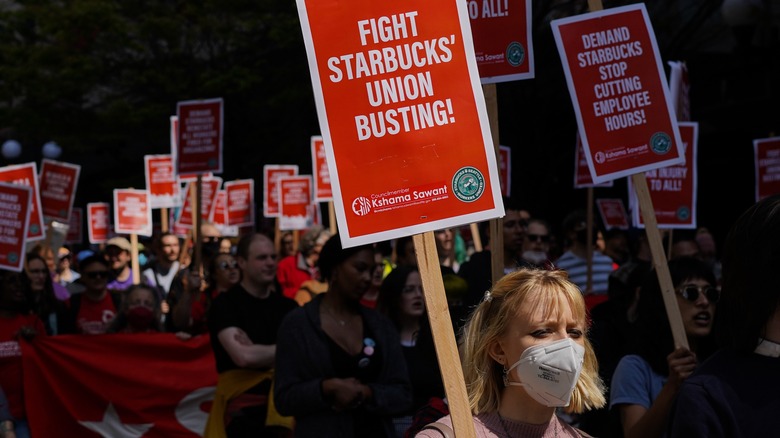Why Restaurants Should Be Supporting Union Efforts, Not Fighting Them
As the American restaurant industry continues to recover from the significant loss of jobs and earnings in the wake of the COVID-19 pandemic and continues to struggle with historic labor shortages that have left many restaurants understaffed, some experts are urging restaurant owners to embrace an unexpected source in order to win back workers (via National Restaurant Association).
Recently, labor shortages have plagued food service providers across the U.S. even as the industry has rebounded from pandemic closures (via Insider). A report by the National Restaurant Association found that 7 out of 10 restaurant owners faced crippling staff shortages as of early 2022 and half of all restaurant owners cited recruiting and retaining workers as one of their biggest challenges this year.
In order to reverse this labor trend, one start-up CEO has urged restaurants struggling to attract employees to turn to a source typically maligned by business owners and corporations: unions. In a QSR Magazine editorial, Andrew Duffy, founder and CEO of Sparkplug, an employee-incentive platform used by restaurants and retailers to motivate workers more effectively, argues that unions could be a beneficial tool to the restaurant industry as a whole.
Unions are organizations formed and led by workers that share a common company, trade, or industry, and are dedicated to improving the overall working conditions for laborers. Unions take care of everything ranging from negotiating salary increases and benefits, to advocating for reduced workday lengths, and also for safer job sites (via Investopedia).
Labor unions advocate for the wellbeing of workers
Although large-scale unionization efforts have recently made national headlines, labor unions are as old as the United States itself. According to History, the first American union was founded in 1794; laying the groundwork for countless influential unions that followed in its path (via Yahoo).
Despite the rich history of American unions, historically, many employers have been predominantly anti-union. Such is the case with Amazon, which has spent millions on union busting in recent years in order to preserve the company's profit margins (via The New York Times). However, as increasing numbers of American workers refuse to return to workplaces where ample pay, benefits, and worker protections aren't in place, unions may be the answer to the restaurant industry's workforce woes.
Duffy cites recent widespread unionization efforts by employees of major corporations (like Starbucks) as well as small businesses (like the Wisconsin-based Colectivo Coffee and the popular Oregon-based donut chain Voodoo Doughnuts) as an indicator of the growing trend in American workplaces.
Although the restaurant and food service industries have comparatively low levels of union membership (about 3.4% of the total food and beverage workforce is a member of a union, compared to 10.8% of union workers across all industries, per Marketplace), more and more workers in the culinary space have shown interest in unionizing in recent days.
Recent unionization efforts at Starbucks and Amazon have made headlines
"Union activity has always coalesced as a collective response to corporate overreach," said Duffy in his QSR Magazine piece. "During the pandemic, where frontline workers were asked to put themselves in harm's way, for longer hours, without seeing those sacrifices reflected in pay and benefits, it fostered an air of resentment."
The Sparkplug CEO argues that unionization would incentivize restaurant industry workers to head back to work and stay in positions longer thanks to union-led benefits like higher pay, more sanitary workplaces, better work-life balances, and a "seat at the bargaining table" with their employers.
"In an era where companies are desperate for workers and are already offering higher pay and better benefits to attract talent, unionization and the contract negotiation process can be a valuable way of fixing cracks in the employee relationship, attracting new talent, and fostering employee retention efforts," Duffy notes. He goes on to argue that workers who are given livable wages, better workplace conditions, and improved benefits are more likely to be satisfied, productive workers, presenting a win-win scenario for business owners and employees alike.
"In the end, what all of this contention boils down to is employees feeling valued; and value can take many forms," the CEO says, noting that many restaurants are already offering "higher starting pay, signing bonuses, and additional benefits packages" to draw new workers. Embracing unions may be the next step in solidifying those improved working conditions.


